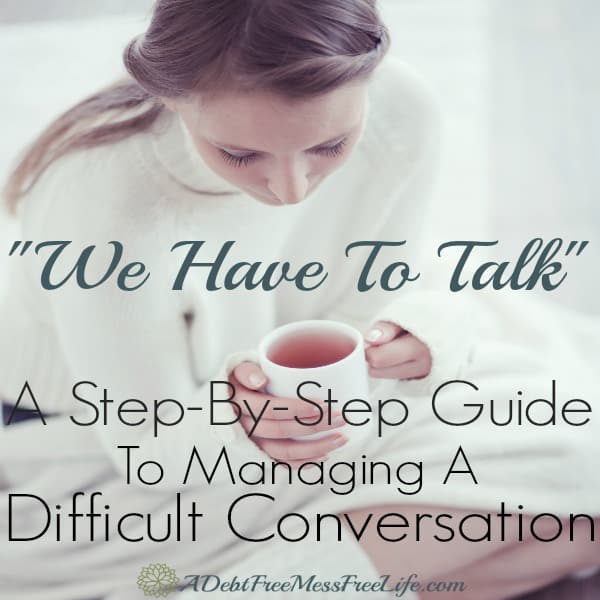A Mess Free Life may collect a share of sales or other compensation from the links on this page.
Do you have to have a difficult conversation with your husband, child, coworker or boss?
Have you been tossing and turning at night trying to figure out how to have this conversation without the whole thing blowing up in your face?
I remember when I had my one and only fight with my friend Terrie. I didn’t apply any of the strategies I’m going to share with you here, and it turned out awful.
It was a painful conversation, and if our relationship wasn’t as stable as it was, it could have been a friendship ending conversation to boot!
If you want your next awkward conversation to go more smoothly, these step by step strategies will have you feeling a lot more confident when you say “We have to talk.”
Table of Contents
A Step By Step Guide for Managing A Difficult Conversation
We have all been faced with those times when you know you should talk to someone, but you don’t. Maybe you’ve tried before, and it went badly. Or perhaps you fear that talking will only make the situation worse. Still, there’s a feeling of being stuck, and you’d like to free up that stuck energy for more useful purposes.
This guide is a brief highlight of best practice strategies: a checklist of action items to think about before going into the conversation; some useful concepts to practice during the conversation; and some tips and suggestions to help your energy stay focused.
You’ll notice one key theme throughout – you have more power than you think.
Related: How To Let Go of Anger When You Don’t Want To
How To Prepare Yourself
1. Before going into the conversation prepare yourself by asking yourself the following questions.
- What is your purpose for having the conversation?
- What do you hope to accomplish?
- What would be an ideal outcome?
You may think you have noble goals, like educating an employee or increasing connection with your teen, only to notice that your language is excessively critical or condescending. You’re trying to be supportive but find in the end that you’re punishing.
Some purposes are more useful than others. Make sure that the purpose is valuable and will deepen the relationship not make it worse. Work on yourself so that you enter the conversation with a supportive plan.
2. What assumptions are you making about this person’s intentions?
You may feel intimidated, belittled, ignored, disrespected, or marginalized, but be cautious about assuming that that was their intention. Just because you think this was their intent, more often than not we are wrong in our assumptions.
3. What “buttons” of yours are being pushed?
Sometimes we are more emotional than the situation warrants? Take a look at your “backstory,” as they say in the movies. What personal history is being triggered? You may still have the conversation, but you’ll go into it knowing that some of the heightened emotional state has to do with you.
4. How is your attitude toward the conversation influencing your perception of it?
If you think this is going to be horribly painful, it probably will be. If you truly believe that whatever happens, some good will come of it, that will likely be the case. Try to adjust your attitude to ensure the best possible outcome.
5. Who is the person on the other side of the table?
If you see them as an opponent, it will make the conversation more difficult. If on the other hand, you see them as your partner in making things better, the outcome may surprise you.
6. How have you contributed to the problem? How have they?
Sit down and map out the contributions of both parties. This way you can readily see your role in the conflict as well as theirs. Remember, no conflict is one-sided. It’s essential for you to take personal responsibility for where things went wrong.
Related: What Ever Happened To Personal Responsibility?
4 Steps to a Successful Outcome
The majority of the work in any difficult conversation is the work you do on yourself. No matter how well the conversation begins, you’ll need to stay in charge of yourself, your purpose and your emotional energy.
It takes work. It sometimes requires you to change and grow.
Just keep centered and make the commitment that when you become off-center, you’ll choose to return to centeredness.
This is where your power lies: by being able to choose a calm centered state. This will help your opponent/partner be more centered too.
Read: 31 Meaningful Things I Do Daily That Makes My Life Better
Step #1: Discovery
When you go into an awkward conversation, start by discovering everything you can about your opponent/partner and their point of view.
Pretend in your mind you don’t know anything about them or how they feel. Truth be told, you really don’t. Time and time again we make assumptions about what a person’s actions or words actually mean without every asking them for clarification. Now’s the time to do just that!
Watch their body language and unspoken words too.
Let them talk freely until they are finished. Don’t interrupt and whatever you hear don’t take personally.
Just learn as much as you can during this phase of the conversation. Remember you’ll get your turn so don’t rush the process.
Read: How To Free Yourself From The Past
Step #2: Acknowledgment
When you acknowledge another person, you show them they have been heard and understood. At this stage you want to demonstrate to the other person, you can make their argument for them and then do it.
Explain back to them what they just said and honor their position.
Acknowledge whatever you can, including your own defensiveness if it comes up.
For example, in an argument with a friend I said: “I notice I’m becoming defensive, and I think it’s because your voice just got louder and sounded angry. I just want to talk about this topic. I’m not trying to persuade you in either direction.” The acknowledgment helped him (and me) to recenter.
Acknowledgment can be difficult if we associate it with an agreement. Keep them separate. My saying, “this sounds really important to you,” doesn’t mean I’m going to go along with your decision.
Step #3: Advocate
When you sense that they’ve expressed themselves fully on the topic, it’s your turn. What can you see from your perspective that they’ve missed? Help clarify your position without minimizing theirs.
For example: “From what you’ve told me, I can see how you came to the conclusion that I’m not a team player. And I think I am. When I introduce problems with a project, I’m thinking about its long-term success. I don’t mean to be a critic, though perhaps I sound like one. Maybe we can talk about how to address these issues so that my intention is clear.”
Read: How to Manage the Pitfalls of Simplifying Your Life
Step #4: Problem-Solving
Now you’re ready to begin building solutions.
Brainstorm solutions and continue asking questions to clarify positions. Ask your opponent/partner what they think would work. Whatever they say, find something that you like and build on it.
If the conversation becomes adversarial, go back to discovery. Asking for the other’s point of view usually creates safety, and they’ll be more willing to engage.
If you’ve been successful in centering yourself and adjusting your attitude, and discovering, finding sustainable solutions to the problems will be easy.
Practice, practice, practice! The art of conversation is like any art – with continued practice you’ll become more proficient.




